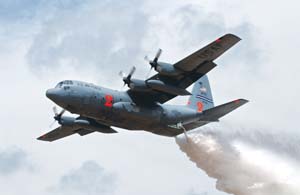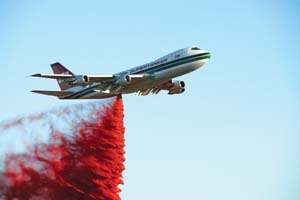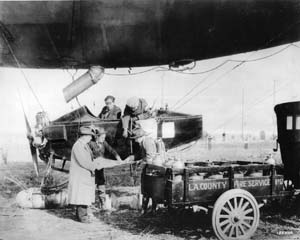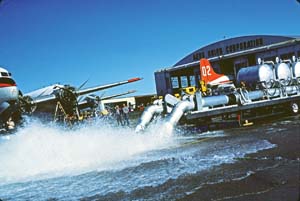Many have watched—perhaps on the evening news or maybe in person—as a thundering aircraft barreled through smoky skies to discharge a bloom of red fluid over a wildfire. The Air Force has been an interested but largely unheralded contributor to this mission since the end of World War I, and USAF continues to play a critical role battling wildfires to this day.
The frequent inaccessibility—and scale—of wildfire sites makes aircraft especially attractive tools to subdue fires. As the western United States became increasingly populous in the early 20th century, the Pacific Northwest was scarred by out-of-control fires that burned three million acres in Montana, Idaho, and Washington in August 1910. Spurred by winds, the Northwest fires of that year burned an area the size of Connecticut in two days. Seventy-eight firefighters and eight residents died. Smoke darkened the sky hundreds of miles away as 1910 became a benchmark year still visible in ancient charred stumps.
To a growing nation only recently realizing its coast-to-coast dream, the loss of so much timber was a financial and strategic wound to be healed.
 |
A Reserve C-130 equipped with the Modular Airborne Firefighting System. ( USAF photo by TSgt. Rick Sforza) |
The fires of 1910 set in motion national wildfire policy for the first time. The policy idealistically expected all reported fires to be extinguished by midmorning the day following their discovery.
While foresters pondered how to check fires such as 1910’s “Big Blow-up,” California’s magnificent Sierra Nevada mountains provided the terrain to generate thunderstorms that hurled incinerating lightning into the trees, burning resources and habitat each summer. Fire crews then attacked the blazes from the ground, but success depended largely on how quickly they could get to a nascent fire.
Air Service Curtiss JN-4 Jenny biplanes flew fire patrols over mountainous California beginning in June 1919, adding their wilderness reach to the effort until they were replaced by larger de Havilland DH-4 aircraft.
Limitations on radio effectiveness led the fire spotter crews to relay fire sightings by air-dropped messages and carrier pigeons. Budget shortages handicapped a promising patrol mission for the Air Service, with the deHavillands sometimes grounded for lack of gasoline.
“Army airplanes and captive balloons will cover portions of the national forests of California, Arizona, New Mexico, and other states this summer, to aid in detecting and suppressing forest fires,” American Forestry reported in May 1919. The Air Service was to “cooperate with the Forest Service of the United States Department of Agriculture in this work, [and] conferences are under way to determine where, and to what extent, the air scouts will supplement the forest rangers.”
The forestry journal explained, “That there is a distinct and important place for aircraft in fire protection of timberlands is regarded by the forestry officials as beyond doubt, but experimental trial of methods and possibilities will have to be the first step.”
As early as 1919, the use of aircraft to attack fires was posited: “It is believed that bombs charged with suitable chemicals can be used with good results.”
 |
A modified 747 releases fire retardant during a grid test. ( |
Less prescient, though undeniably imaginative, was an idea calling for “transporting firefighters by dirigibles from which ladders can be lowered to the ground.” But the main thrust for aircraft in wildfire control in 1919 was fire detection.
“At present the Forest Service relies for this partly on patrol, usually by men on horses, motorcycles, or railroad speeders, and partly on watchers stationed at lookout points. Aircraft have many points of obvious superiority for both classes of detection work,” the forestry journal explained.
“Airplanes would use wireless in reporting fires, as they have done in communicating with the artillery,” the article noted. The time was only 16 years after the Wright brothers’ first flight, and American experience in the air was both short and limited in breadth. “From the Army standpoint, the use of aircraft in protecting the national forests affords a valuable opportunity for training fliers and developing further the possibilities of aircraft and the art of flying.”
“Army aviators, while patrolling their aerial beats along the Mexican border, will take time to locate forest fires on the Coronado National Forest, in southern Arizona,” the American Forestry Association reported in May 1920. “Aviators will be permitted to leave their border patrol in order to ascertain the exact location of forest fires, and in certain cases, special patrol trips may be undertaken with the permission of the district commander of the air service. … When forest fires are discovered by the airmen, notice will be telegraphed to the nearest forest ranger.”
The Water Solution Results from 1920 Air Service fire-spotting flights in California encouraged foresters. More than half of the 196 forest fires discovered and reported by fliers from the 9th Aero Squadron operating out of Mather Field near Sacramento were reported with coordinates that had an accuracy of one-half mile—guiding ground crews to the locations. Eighty-three fires were reported by the pilots expeditiously using radio.
When a wildfire blackened 25,000 acres in Lassen National Forest, “a special reconnaissance plane, equipped with radio and with a forest officer for observer, hovered over the fire and actually directed the movements of bodies of forest [firefighters] by wireless messages received right on the fire line.” This aircraft also patrolled a completed, unattended fire line stretching 14 miles. “If reports from the air showed the line to be clear, the firefighters were kept at work elsewhere, but if the observer wirelessed in that the fire had broken away, then a force of men was rushed to the spot and the fire corralled again.”
By 1924, Air Service patrols had been discontinued over California at least in part as a funding issue and, according to one account, because increased numbers of fixed lookouts were on station all day, while aircraft could provide patrol coverage for only a few hours.
In early 1925, the Forest Service arranged with the Air Service to patrol Northwest forests. Three de Havilland DH-4s were assigned. Larger-than-life Spokane, Wash., pilot Nick B. Mamer and two other Air Service reserve officers flew the patrols.That same year, the Secretary of War suggested future fire patrols should be mounted by commercial fliers in arrangement with the Department of Agriculture, to remove the government from competing with private industry.
Sequoia National Park Superintendent John R. White wrote an after-action report on a 1926 fire at Kaweah in California’s beautiful Giant Forest in the Sierra Nevada mountains. His efforts at scoping out the size of the fire included a de Havilland that picked him up at Fresno, Calif. White flew for two hours over fire-threatened areas, “getting a splendid view of the fire and an opportunity to study the terrain on the fire line which could only have been obtained otherwise by several days on foot and horseback.”
Back on the ground, White “telephoned instructions for changes on the fire line and also laid off 100 men … whom I considered surplus. It is no exaggeration to say that this airplane trip saved the government several hundred dollars a day in labor alone for a period of several days.”
If airplanes could fly over a fire, why couldn’t they drop water on the fire? California pilot Charlie J. Jensen installed a pair of watertight hoppers on either side of a surplus Jenny biplane and made two drops on a fire east of Oroville, Calif., in 1931.
In 1943, the Northern Rocky Mountain Forest and Range Experiment Station published a paper by Roy Headley, titled, “Rethinking Forest Fire Control.” Headley recounted the post-World War I era, saying, “It was natural that many men wondered why fires could not be ‘bombed’ with fire-retarding or fire-extinguishing chemicals.”
William B. Greeley, then chief of the Forest Service, accordingly organized a cooperative study with the Chemical Warfare Service of the Army. They concluded that there was no worthwhile practicable use to be made of any known chemicals, but into the 1930s the Forest Service had spent time and money researching ways to drop chemicals or explosives from aircraft to attack fires. Tests included the use of monoammonium phosphate as a retardant added to water. Foaming agents were tested as far back as the 1930s, but the viability of air tankers remained an illusive goal.
Forest Service testers in the 1930s also contemplated the effectiveness of explosive bombs, according to Headley, “which would throw dirt on the edge of a fire and thereby retard its spread.”
 |
Los Angeles County officials pore over maps next to an airship and county trucks loaded with firefighting equipment. ( |
Headley’s paper cites the decisive obstacle to successful aerial firefighting at that time as “inability to hit the target.” His 1943 study bluntly offered, “Whatever the truth may be about military ‘precision’ bombing, protracted effort failed to attain enough accuracy in bombing fires to make the method worthwhile.”
This included chemical bombs; the concept of free-fall liquids had not gained traction.
In his report, Headley imagined a list of firefighting agents that helicopters could release, such as “chemical solutions or dusts, dirt-throwing explosives, diatomaceous earth, Portland cement, or even plain water.”
The Scramble In the summer of 1947, a Republic P-47N Thunderbolt at Eglin Field, Fla., performed a military test of firefighting theory by releasing a pair of water-filled 165-gallon drop tanks. In July, two P-47Ns and a B-29 flew to Great Falls AAB, Mont., on the eastern edge of Montana’s divide between open range and forest land, to explore aerial firefighting. Test fires in the Lolo National Forest were targeted, followed by sorties against actual wildfires in western Montana. Forest Service emblems were applied to the B-29 and at least one of the Thunderbolts.
The Thunderbolts dropped a total of 56 tanks, some fitted with stabilizing fins as well as unfinned teardrops. The pilots employed both glide bombing and dive bombing approaches to fires. Finned tanks were used for the P-47 dive bombing runs, which were discontinued in favor of glide bombing passes with unfinned tanks. Tanks dropped by the P-47s were expected to rip open on impact, spewing water over the fire area. Initial results indicated the P-47 drops were superior to those made by the B-29.
The giant B-29 Superfortress, nicknamed the Rocky Mountain Ranger, cast a big shadow from its 141-foot wingspan over the Montana forest tests as it hefted eight 165-gallon drop tanks in its bomb bays. Weighing about 1,000 pounds each when filled with water, these tanks were armed with proximity fuses set to explode and rupture the tanks 50 feet above the ground to foster maximum dispersion of the water and some chemical fire retardants. The Superfortress dropped 46 tanks on test fires during seven missions flown typically at 3,000 feet. One tank could cover a swath 48 feet wide and 108 feet long.
An Aerial Bombing Evaluation Board composed of seven forestry specialists and one lieutenant colonel from the Army Air Forces Air Proving Ground Command observed the tests. The summer of 1947 was a transitional period at once filled with hope and uncertainty, and not yet infused with the Cold War urgency that would follow. Into this arena, a vastly downsized military stood to benefit from meaningful missions.
The Aerial Bombing Evaluation Board opined that deployment of warplanes as firefighters “will help maintain high esprit de corps of military personnel in peacetime by assignment to productive missions that contribute to training.”
“After this brief survey, we feel that this method of fire suppression offers definite promise for the better protection of lives and property,” the board members confidently reported. “The present project already has proved that military aircraft can be flown in mountainous areas and that tanks containing extinguishing agents can be dropped with sufficient accuracy to hit and retard the spread of small fires.”
A proposal to deploy 75 fighters and 30 B-29s as fire bombers for the 1948 wildfire season went fiscally stillborn.
If hindsight questions the use of fuzed bombs over domestic forests, the Air Force tests nonetheless pointed the way toward aerial delivery of water and fire retardant over wildfires.
The concept of aerial firefighting was not yet deemed practical. Water bombs weren’t the answer, and according to one Forest Service official, the value of wildland resources had not yet appreciated enough to overtake the considerable costs of retardants and aircraft to deliver them.
That began to change in the 1950s.
Modern air tanker technology was suggested by serendipity in the latter half of 1953. The prototype Douglas DC-7 four-engine airliner was fitted with water ballast tanks to enable flight-test crews to alter the aircraft’s center of gravity for testing handling.
 |
The Modular Airborne Firefighting System dumps hundreds of gallons of water on the ramp during a test at Chico, Calif., in 1985. ( |
On one test flight, the Douglas flight crew jettisoned 1,300 gallons of free-falling water over the runway at Palm Springs, Calif., laying down a wet swath 200 feet wide and nearly a mile long. The implications were obvious—and exciting.
In early 1954, Marine Corps Reserve pilot Maj. Warren Schroeder tested a different free-fall drop system while flying a Douglas AD-2 Skyraider.
The Skyraider carried a 250-gallon napalm tank, the ends modified to use glass plates that could be broken by detonators activated by the pilot. A solution of water and foam was released from a height of about 35 feet at 160 mph. The Skyraider placed a visible pattern on the ground 50 feet wide and 300 feet long.
The scramble to create usable firefighting aircraft was on. Forays with biplane PT-17s and N3Ns were promising, if on a small scale. Forest Service and private operators quickly embraced the single-engine Grumman TBM Avenger torpedo bomber as a workable, and available, surplus bomber. Surplus B-25s, and then B-17s, PB4Y-2s, and other used ex-military aircraft filled the ranks of this new occupation.
Aerial firefighting grew into the 1960s as an entrepreneur’s dream played out by plucky civilians.
Air National Guard and Air Force Reserve C-130s became part-time firefighters with the introduction of the Modular Airborne Firefighting System, or MAFFS. The roll-on, roll-off system of tanks and discharge mechanism could equip any C-130. First generation MAFFS versions discharged retardant off the back ramp of the C-130.
Starting in 1971, Guard and Reserve C-130s have participated in annual wildfire suppression missions. Typically, military C-130s are called only when all commercial equipment has been used or there is a threat to life; the Forest Service then arranges for Guard or Reserve firefighting assistance. Personnel and equipment are then under the direction of the Forest Service.
Carrying the System MAFFS was designed by FMC Corp.’s Defense Technology Laboratory in San Jose, Calif., for the Air Force. The system was developed in rapid fashion between March and October 1971, when it was first used on a wildfire.
Aero Union of Chico, Calif., picked up the MAFFS and developed it further.
The next generation MAFFS II firefighting system is suitable for C-130 E, H, and new J models. The upgraded system can carry 3,000 gallons of retardant in a pressurized tank. The retardant exits through a nozzle in a special paratroop door plug at the side of the fuselage to the rear. This allows the C-130 to remain pressurized, providing crew comfort and safety benefits.
The MAFFS II does not need time-consuming modifications, enabling quick conversion to and from the fire suppression mission. The modular unit can disgorge retardant in variable amounts, depending on the nature of the fire. This includes a saturation of eight gallons of retardant for every 100 square feet of surface to be covered, doubling the coverage possible with older MAFFS units.
Four C-130 units today fly MAFFS. Three are Air Guard: the North Carolina Guard’s 145th Airlift Wing, the California Guard’s 146th Airlift Wing, and the Wyoming Guard’s 153rd Airlift Wing. They are joined by the Air Force Reserve’s 302nd Airlift Wing from Peterson Air Force Base in Colorado.
The advent of stretched, upgraded C-130Js mated to the new modular system promises better, safer performance. Future MAFFS tanks may increase capacity to 4,000 gallons—thanks to a 12 percent increase in C-130J power.
MAFFS II “is head and shoulders” better than the first generation system, according to officials with the 146th AW at Channel Islands Air National Guard Station, Port Hueneme, Calif. The new system’s modern head-up displays in the C-130J give firefighting pilots easier situational awareness over a crowded and smoky fire scene.
The wing knows a few things about aerial firefighting. It has flown MAFFS since 1974, and officials note that the “Malibu fires of 1993 literally burned to the edge of our base.”
MAFFS crew postings are prized in the wing, notes the 146th’s Maj. Kimberly Holman. “They take the best of the best,” she explained, and not all C-130 crew members are MAFFS-rated.
The development of aerial firefighting techniques and hardware in the United States illuminates the seesaw between proponents of government programs versus private industry. Sometimes, only the Air Force had the hardware available; now, modern iterations of civilian-owned air tankers include promising conversions of huge 747 and DC-10 jet airliners.
But ingenuity and vision were required to conceive ways to leverage the promising capabilities of aircraft over wildfires. Airmen seeking meaningful work during the force drawdowns following both world wars contributed greatly to today’s aerial firefighting capability.
Frederick A. Johnsen is the director of the Air Force Flight Test Center Museum at Edwards AFB, Calif. He is the author of more than 24 books and monographs on aviation topics, including Fire Bombers in Action. His most recent article for Air Force Magazine, “The Making of an Iconic Bomber,” appeared in the October 2006 issue.